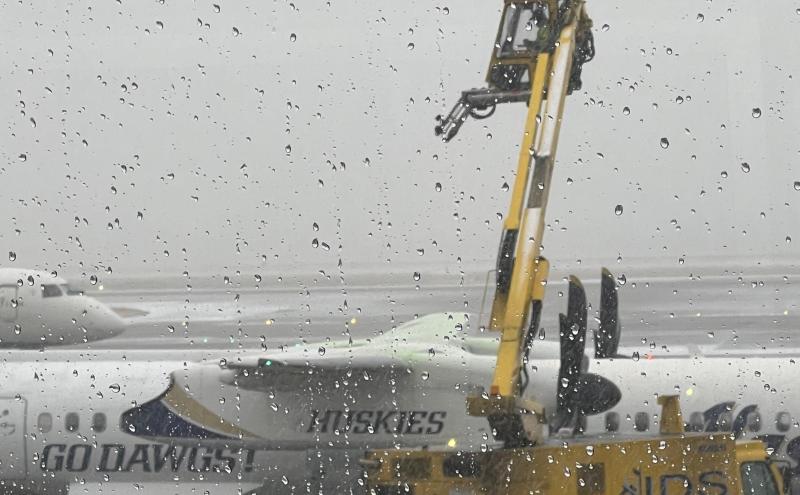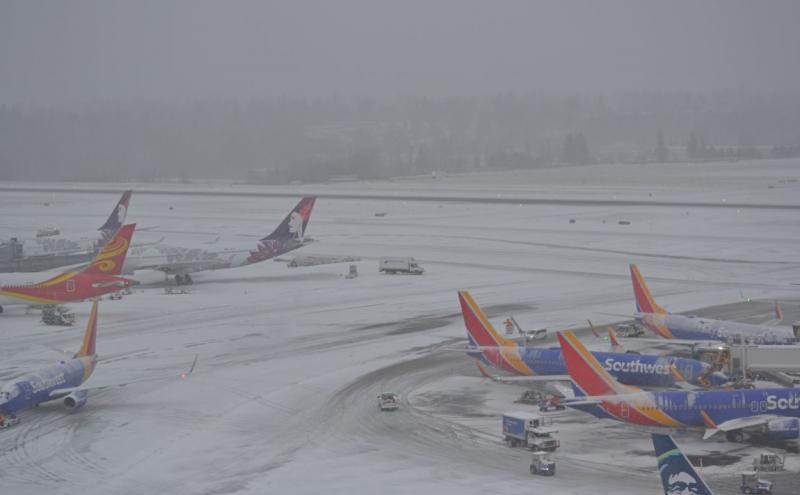
Originally published February 2021; updated January 2024.
When the weather outside is frightful … and you’re worried your trip won’t be so delightful, here is everything you need to know about Seattle-Tacoma International Airport’s (SEA) winter weather operations. We don’t want to go so far as to say “Let It Snow.” But if it does, we will be ready.
SEA is one of the top 12 busiest airports in the country and averages 1,200-1,300 flights per day. So, as you know, even a little bit of bad weather can have a big impact on flight operations. The Airport team works all year and around the clock to prepare for, respond to, and communicate with you about inclement weather, whether it’s rain, snow, sleet, smoke, or fog.
In a normal season, SEA Airport budgets about 4,000 hours for snow removal. In the last 10 seasons, the airport has seen an average of six inches of snow. The biggest season in that period was 2018-19 with 21 inches, followed by 2020-21 with 12.9 inches and 2016-17 with 11.2 inches.
PREPARE
Bad weather is rarely a surprise to the airport team. Before you even know it’s coming, the SEA team has been getting ready and planning for the worst. Here’s how.
Watch the Weather
SEA Airport has access to weather information through NOAA and the National Weather Service 24 hours a day, 7 days a week, 365 days a year. There is a National Weather Service weather sensor right at the airport for accurate readings and the airport contracts with an additional weather provider for custom weather forecast reports.
Control the Snow
Before winter weather begins, the airport opens the Snow Control Center, a central management operation for all airport snow and ice control activities. It facilitates communications and speedy decision making in a larger snow and ice event.
Assemble the Snow Team
The snow team is made up of 99 people — 74 members of the Port and SEA teams who are trained in snow removal, and 25 mechanics standing by to make sure the equipment works. By the time bad weather hits, the snow team has already been preparing. Months before, they begin checking the equipment, stocking up supplies like sand and de-icer fluid in the snow shed, practicing with the equipment, and getting ready for the inevitable.
Get the Equipment Ready
SEA Airport has more than 50 pieces of equipment on hand for snow and ice maintenance including:
- 17 plow and broom combination units. 9 tractor trailer units with 24-foot plows. 8 fixed-chassis units with 20-foot plows
- 2 friction testers to measure stopping distance for the runways
- 4 high-speed brooms
- 3 sander plows
- 4 high-speed plows
- 4 de-icing trucks for runways/taxiways and ramp areas, 3 with 75-foot booms and 1 boomless with a 50-foot spray width
- 5 snow blowers used on the runways
- 4 dump trucks with plows and de-icing and/or sanding capabilities dedicated to landside
- 8 pickup trucks with plows and de-icing and/or sanding capabilities dedicated to landside
- Walk-behind snow blowers and brooms
- Lots of snow shovels and team members ready to work
Practice Makes Perfect
Every November all members of the snow team go through recurrent training. The ops staff review the snow and ice control plan, and re-familiarize themselves with the snow alert levels. The maintenance staff reviews the plans, but they also go out in the snowplows and do mock snow removal exercises on the airfield.
Stock Up on Supplies
The airport stocks up the snow shed with runway de-icer and sand. The following supplies are on hand and ready for deployment:
- 62,000 gallons de-icing fluid (for runway, taxiway, and ramp use)
- 300 tons of roadside sand
- 350 tons of runway sand (fine grade and approved by the FAA)
- 70 tons of dry chemical (used with sand)
- De-icing chemicals to be spread by hand on stairways around the terminal
RESPOND
When Mother Nature gets cranky, winter weather operations kick into high gear. During a weather event here’s what’s happening behind the scenes.
De-ice the Aircraft
The fluids used for de-icing airfield pavement are different than the substances used to de-ice airplanes. Chemicals are sprayed on the wings and fuselage of a plane to prevent icing. Each of the airlines are responsible for providing de-icing fluids and applying it to their planes.
Remove Snow on the Runway
On the airfield, SEA Airport handles all common use areas and manages de-icing of the runways, taxiways, ramp areas in and around the gates and cargo area, and adjacent airport roadways. Airlines are responsible for clearing ice and snow from their specific gates.
Snow removal on the runways takes place with several snow plows stretched out at an angle with snow blowers following.
- It can take 30-45 minutes to clear a runway, and the Snow Team works as quickly as possible so aircraft can continue to arrive and depart. The current operations goal is under 30 minutes.
- The Port of Seattle maintains a stock of special sand that meets FAA specifications and can used without damage to aircraft. Sand is provided to airline partners at no charge.
Snow removal happens in the following order:
Priority 1: Runways, taxi lanes, and taxiways
Priority 2: Hardstands (when an airplane is parked and passengers are transported by bus to the airports. SEA uses this operation to get passengers on and off planes more quickly rather than waiting for a gate during busy times).
Priority 3: Bagwell ramps, vehicle service roadways, sloped roads
- Video: Check in with the SEA Airport Snow Team and see their equipment
De-ice the Runway
De-icing occurs before snowfall when temperatures reach 33-34 degrees. De-icing fluid works to stop ice from bonding to the concrete. The runways have embedded temperature monitors that allow staff to apply de-icing fluid only when necessary in order to conserve the supply. The airport uses biodegradable potassium acetate as a liquid runway de-icer. A solid runway deicer, sodium acetate, also is used at lower temperatures. On-site tanks store 62,000 gallons of de-icing fluid and supplies are restocked during the winter to maintain an acceptable stockpile.
In case you’re wondering about the environmental impact, the de-icer solution used on the ground does not harm streams. The airplane de-icing solution is collected through an industrial wastewater system and is sent for secondary treatment at a King County treatment plant.
- Average fluid used per season: 36,000 gallons
- Total de-icing fluid used 2021-2022 season: over 120,000 gallons
Remove Snow around the Terminal
SEA Airport is responsible for maintaining the terminal and facilities, including:
- Keeping the terminal area free of snow and ice
- Maintaining the parking garage and roads and drives, including Starling Road, Air Cargo Road to the Employee Parking Lot and the Airport Expressway just north of the return-to-terminal loop
- Sanding the roadways (with a different type of sand than is used for planes)
- During heavy snowfalls of two inches or more and accumulating, the Port hires two contractors to remove and collect snow piles. One for the north side of the ramp, and one for the south end.
Transport Employees and Travelers Safely
The Port monitors the roadways and facilities around the airport for snow and ice. This includes airport ground transportation, public parking, and employee parking. And the buses between the terminal and the employee parking lots and rental car facilities.
- The eighth floor of the parking garage has sensors and is closed during snow or in low temperatures
- The helixes in parking garages are monitored hourly for snow and ice
- The goal is passenger waiting times of less than five minutes at rental car facility
In case you’re curious, here are a few stats about ground transport operations:
- 426 trips per day between the terminal and rental car facility
- Buses carry 10,000 people per day on 29 buses
- With staffing of 58 bus drivers, 13 support staff, 12 bus mechanics, and 8 staff who fuel and clean buses
Deal with Fog and Low Visibility
Flights can be delayed in the event of low visibility like snow, fog, and even smoke from forest fires.
- Video: See a Facebook Live Video about the basics of air traffic control and what happens in a low visibility situation.
WEATHER TERMS
Here are a few terms you may hear during weather operations.
Gate Hold
A gate hold is when aircraft are required to stay at the gate until air traffic has a spot for them to depart and is managed by the Federal Aviation Administrator or the Port.
What Is a Ground Stop?
A ground stop is a traffic management procedure taken by Air Traffic Control (ATC) during low visibility periods for the safety of aircraft, passengers, and operators. Most often ground stops are used to hold aircraft on the ground at originating airports before they head to their destination.
With reduced visibilities, the arrival rate would be reduced. On a typical sunny day here at SEA, the airport could see 50 aircraft arrivals per hour. On a hazy, foggy, or snowy day, it could decrease to 25 or fewer arrivals per hour in worst cases. Simply put, as it gets harder to see, safety procedures require ATC to build in greater distance of separation between aircraft, thus fewer can land within that hour.
A ground stop allows ATC to ‘meter’ traffic to the destination airport. This process spreads out traffic volume along the flight path to match the arrival rate so when aircraft get to the destination they won’t be delayed further for landing clearance. Often this can be as little as 15-30 minutes to clear volume congestion within the route and the aircraft is released from its origination airport.
Every flight is different depending upon departure time, destination, and international or domestic origin. So don’t assume that all flights are delayed – check with your airline for the most up-to-date information.
COMMUNICATE
There are several tools you can use to find out what is happening during a weather incident and year-round.
SEA Airport Home Page
If there is a weather event or other incident, check the SEA Airport home page for a colored alert bar or an incident advisory graphic.
Flight Aware’s Flight Cancellations Page
The Flight Aware site tracks airport delays and cancellations daily. To track SEA Airport flight status, enter "KSEA" into the "Filter all stats by airport" box.
SEA Flight Information Online
The Flight Status page provides the same information seen on the in-terminal flight information displays, which comes directly from the airlines. You can use this page to check the status of specific flights, or delays to or from another airport. For example, to check delays or cancellations for flights to Chicago, select the Chicago airport under Destination, then leave the Select Airline field blank.
Or contact your airline directly about your flight status.
Weather Conditions at SEA Airport
Get the latest conditions and forecast from NOAA/the National Weather Service.
SEA Airport App
Download the SEA Airport app for your iOS and Android devices to get updates on your flight and security checkpoint wait times.
SEA Airport Social Media
Real-time updates are posted to the SEA Airport Facebook page and X feed.
SEA Airport Text Alerts
Sign up to be notified of a weather incident or receive alerts during peak travel periods.
Sound Transit Alerts
View service alerts or sign up for email and text alerts from Sound Transit.









